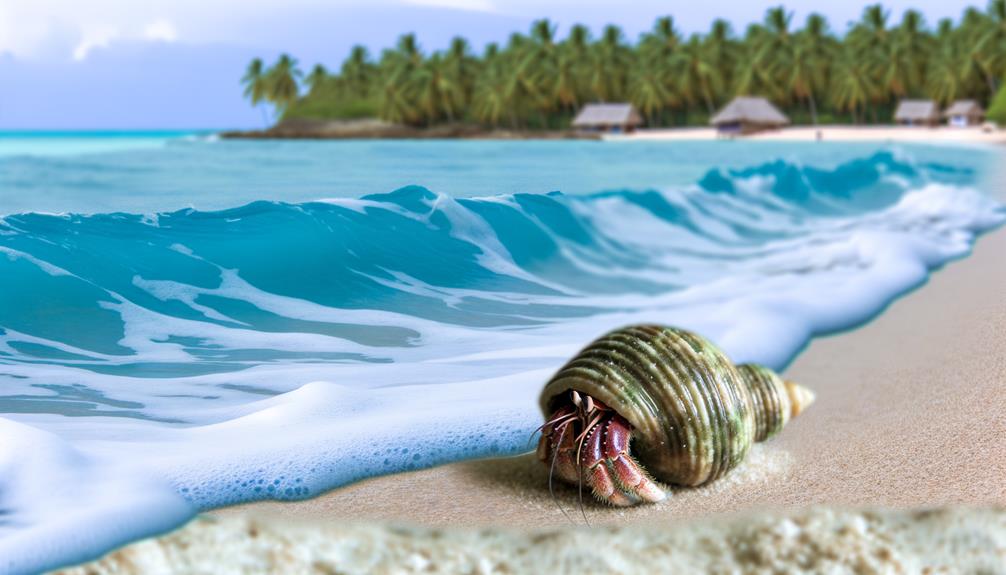Do Hermit Crabs Get Lonely?
Yes, hermit crabs can get cold. As ectothermic animals, they depend on external heat sources to regulate their body temperature.
Ideally, you should maintain their habitat between 75-85°F. If temperatures drop below 70°F, hermit crabs may experience metabolic slowdowns and reduced activity.
Consistent low temperatures can compromise their immune functions and induce stress. Use reliable thermometers and heating sources to provide a stable, warm environment.
Maintaining proper temperatures not only supports their metabolic and enzymatic activities but also prevents cold stress and lethargy. Discovering more about their specific needs can guarantee your hermit crab thrives.

Key Takeaways
- Hermit crabs can get cold and experience stress if temperatures drop below 70°F.
- Cold temperatures cause reduced activity and shell withdrawal behavior in hermit crabs.
- Prolonged exposure to low temperatures compromises hermit crabs' immune function.
- Providing a stable temperature range of 75-85°F prevents cold stress in hermit crabs.
- Consistent temperature monitoring and reliable heating sources are essential for hermit crab well-being.
Hermit Crab Temperature Needs
Maintaining a perfect temperature range of 75-85°F is crucial for the health and well-being of hermit crabs. They are ectothermic animals that rely on external heat sources to regulate their body temperature.
You need to use dependable thermometers to monitor the habitat's temperature consistently. Research indicates that temperatures below 70°F can lead to metabolic slowdown, increased susceptibility to illness, and even death.
Make sure you provide a gradient within the tank, allowing crabs to move to their preferred temperature zones. Using under-tank heaters and heat lamps can help maintain ideal conditions.
Always avoid drastic fluctuations, as they can stress the crabs. By keeping their environment within this specific range, you'll greatly contribute to their longevity and overall health.
Native Habitat Conditions
Understanding hermit crab temperature needs is essential, and examining their native habitat conditions provides further insight into their ideal living environment. Hermit crabs are typically found in tropical and subtropical regions, where temperatures range from 75°F to 85°F. These environments are characterized by high humidity levels, usually between 70% and 80%.
Coastal habitats, often rich in moist sand and vegetation, offer the necessary microclimates for hermit crabs to thrive. In such conditions, they can regulate their body temperature effectively. You must replicate these conditions to optimize their well-being. Consistent temperature and humidity levels are important, as fluctuations can lead to stress or health issues.
Accurately mimicking these native habitats will enable you to provide best care for your hermit crabs.
Temperature Sensitivity
Hermit crabs show significant sensitivity to temperature fluctuations, necessitating precise environmental management to safeguard their health and well-being. Best temperature ranges for hermit crabs typically fall between 72°F and 80°F. Deviations from this range can result in stress and metabolic disruptions.
Research suggests that prolonged exposure to temperatures below 72°F can compromise their immune function and lead to lethargy. Conversely, temperatures surpassing 80°F may result in overheating and dehydration. Monitoring and maintaining stable temperatures within this narrow window is essential.
Utilize thermometers and heaters designed for small enclosures to guarantee accurate regulation. By providing a stable thermal environment, you'll promote their natural behaviors, enhance their longevity, and ultimately optimize their physical and psychological well-being.
Signs of a Cold Hermit Crab
When your hermit crab gets cold, you'll notice a noticeable reduction in its activity levels, as it becomes lethargic and less responsive to stimuli.
Additionally, cold hermit crabs often exhibit shell withdrawal behavior, retreating deeply into their shells to conserve warmth.
Monitoring these signs is important for maintaining their best living conditions.
Reduced Activity Levels
A cold hermit crab typically exhibits reduced activity levels, often becoming lethargic or retreating into its shell for extended periods. You'll notice that it moves less frequently and shows diminished interest in exploring its environment.
Scientific evidence suggests that hermit crabs' metabolic rate decreases in lower temperatures, leading to this behavioral change. For best care, monitor the ambient temperature closely; it should remain within the species-specific range of 72-80°F.
If your hermit crab's activity levels drop, it's essential to gradually warm its habitat to avoid thermal shock. Utilizing a reliable thermometer and heat source can help maintain the proper temperature, ensuring your hermit crab stays active and healthy.
Shell Withdrawal Behavior
Observing your hermit crab retreating deep into its shell for prolonged periods is a clear indicator that it may be experiencing cold stress. Prolonged shell withdrawal reduces exposure to the cold environment, conserving body heat.
Research shows that hermit crabs, being ectothermic, rely heavily on ambient temperatures to regulate their body heat. When temperatures drop below the optimum range of 72-80°F (22-27°C), you'll notice increased shell withdrawal behavior. This behavior, coupled with lethargy and reduced feeding, signifies thermal discomfort.
To mitigate this, optimize your habitat includes a reliable heat source, like a heat mat, and monitor temperature consistently. By doing so, you'll maintain a suitable environment, optimizing your hermit crab's health and well-being.
Ideal Temperature Range
Maintaining an ideal temperature range of 75 to 85 degrees Fahrenheit is crucial for hermit crabs' metabolic functions and overall well-being. This temperature range supports enzymatic activities crucial for digestion and nutrient absorption.
If temperatures fall below this range, hermit crabs may become lethargic, reducing their ability to perform essential activities like foraging and molting. Additionally, suboptimal temperatures can compromise their immune system, making them more susceptible to disease.
Conversely, temperatures exceeding 85 degrees can lead to hyperactivity and increased stress levels, which can be equally harmful. Consistently monitoring and upholding this temperature range guarantees a stable environment that supports the hermit crabs' physiological processes, promoting their health and longevity.
Heating Options
To maintain the perfect temperature range for hermit crabs, various heating options are available that keep their habitat within the best 75 to 85 degrees Fahrenheit.
Under-tank heaters (UTH) are a popular choice, providing consistent heat from beneath the substrate.
Ceramic heat emitters (CHE) offer another reliable option, emitting steady warmth without light, which is essential for nocturnal species.
Additionally, heat mats can be attached to the sides of the tank, guaranteeing even distribution of warmth.
Always use a thermostat in conjunction with these devices to prevent overheating.
Infrared heat lamps are effective but should be used cautiously to avoid desiccation.
Regularly monitor the temperature to ensure the habitat remains within the best range, promoting your hermit crabs' well-being.
Thermometer Placement
To maintain your hermit crabs within their perfect temperature range of 75-85°F, you must place the thermometer accurately within their habitat. Position it at substrate level, near the middle of the tank, to obtain a representative reading of their environment.
Consistent monitoring will provide evidence-based insights to sustain ideal conditions.
Ideal Temperature Range
Maintaining an appropriate temperature range for hermit crabs involves placing a dependable thermometer in the habitat, ideally at the substrate level where they spend most of their time. Hermit crabs thrive in temperatures between 75°F and 85°F. Deviation from this range can lead to stress and health issues.
Use a digital thermometer with a probe for precise readings. Consistent monitoring guarantees the habitat remains within the best range, promoting your hermit crabs' well-being. Sustaining this temperature range helps replicate their natural environment, supporting essential biological functions.
For better accuracy, cross-check readings with a secondary thermometer. Following this ideal range underscores your commitment to providing a nurturing environment, crucial for the well-being of these sensitive creatures.
Accurate Placement Tips
Placing your thermometer at a consistent location within the habitat, particularly at substrate level, guarantees you're capturing the most precise temperature readings where your hermit crabs spend most of their time. Consistency in thermometer placement is essential since temperature gradients can occur within the enclosure.
Substrate-level placement helps confirm readings reflect conditions your hermit crabs directly experience. Evidence suggests that maintaining a stable environment reduces stress and promotes healthier behavior. Use a digital thermometer with a probe for accurate measurement, and periodically calibrate the device to maintain precision.
Avoid placing the thermometer near heat sources or drafts, as this can skew readings. Ensuring precise temperature monitoring helps you serve your hermit crabs' needs more effectively and compassionately.
Seasonal Temperature Changes
Seasonal temperature changes can greatly impact a hermit crab's metabolic rate and behavior. During colder months, hermit crabs exhibit reduced activity and slower metabolic rates due to lower ambient temperatures. It's vital to maintain their habitat within the best range of 72-80°F to prevent these adverse effects.
Studies indicate that temperatures below 72°F can induce torpor, compromising their immune system and increasing susceptibility to disease. Conversely, consistent exposure to temperatures above 80°F may lead to hyperactivity and dehydration.
Monitoring and adjusting the habitat's temperature ensures your hermit crabs remain healthy and active. Employing precise temperature control measures, such as thermostats and heat pads, can deliver consistent thermal environments, essential for their well-being during seasonal fluctuations.
Common Mistakes
You might think using a simple heat lamp is enough, but inadequate heating solutions can lead to serious health issues for hermit crabs.
Another common mistake is assuming room temperature is sufficient, which can cause chronic stress and weaken their immune systems.
Understanding these errors, supported by evidence-based guidelines, is essential for maintaining their well-being.
Inadequate Heating Solutions
Many hermit crab owners make the common mistake of using inadequate heating solutions, such as placing heating pads directly under the tank, which can lead to uneven temperature distribution and stress for the crabs. This method often fails to replicate the natural warmth found in their coastal habitats. Instead, consider using side-mounted heating pads or ceramic heat emitters to provide consistent warmth.
Here's a quick comparison:
| Method | Pros |
|---|---|
| Under-tank heating pads | Easy to install, low cost |
| Side-mounted heating pads | Even heat distribution, prevents substrate drying |
| Ceramic heat emitters | Consistent warmth, safe for long-term use |
| Heat lamps | Provides light and heat, but can dry out the tank |
Adopting superior heating solutions guarantees your crabs thrive without unnecessary stress.
Incorrect Temperature Assumptions
A common mistake in hermit crab care is assuming that room temperature is sufficient for their needs, which often leads to suboptimal living conditions. Hermit crabs thrive in temperatures between 75-85°F (24-29°C), and maintaining this range is crucial.
When temperatures drop below 70°F (21°C), their metabolism and immune system can be compromised, increasing susceptibility to illness. You might think a stable home environment is enough, but fluctuations in household temperatures, especially during colder months, can be detrimental.
Utilizing a dependable thermostat and heating pad specifically designed for reptiles guarantees a consistent habitat. Remember, your dedication in monitoring and adjusting temperatures directly impacts the well-being and longevity of your hermit crabs. Your effort truly makes a difference.
Maintaining Consistent Temperatures
Maintaining consistent temperatures is crucial for hermit crabs' health, as fluctuations can cause stress and potentially lead to fatal outcomes. You should aim to keep their habitat between 75-85°F (24-29°C). Utilize a dependable digital thermometer and position it at crab level for accurate readings.
Installing a low-wattage, under-tank heater or a ceramic heat emitter guarantees stable warmth, avoiding direct contact to prevent burns. Additionally, monitor humidity levels, keeping them between 70-80%, as humidity aids in temperature regulation. Sudden drops can induce a state of torpor, compromising their immune system.
Consistent temperature control not only minimizes stress but promotes active behavior and longevity, crucial for their well-being. Your attention to these details markedly impacts their overall health and happiness.
Conclusion
Ensuring your hermit crab's habitat stays within the ideal temperature range of 72-80°F is essential for their health.
One intriguing statistic is that temperatures below 65°F can lead to a 60% decrease in hermit crab activity levels, greatly affecting their well-being.
Use a dependable digital thermometer, placed at both ends of the tank, to monitor consistency.
Don't overlook seasonal shifts; even slight temperature dips can endanger your hermit crab's health.
Maintain vigilance to provide a stable environment.






